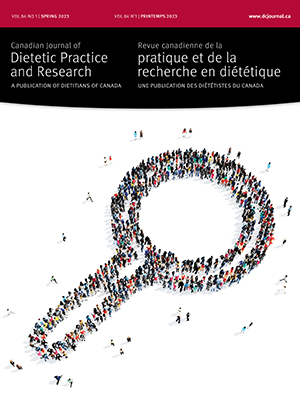Abstract
Purpose: Canada’s Food Guide (CFG) contains recommendations for healthy eating for Canadians. The objective was to examine the awareness of and learning about CFG by Canadian youth.
Methods: Cross-sectional online surveys were conducted with 3,674 youth aged 10–17 years in Canada in November/December 2019. Logistic binary regression models examined awareness of CFG, learning about CFG in school, and learning about healthy eating in schools in the past 12 months.
Results: Most participants reported hearing of CFG (84.5%), learning about CFG in school (86.6%), and learning about healthy eating in school (65.4%) in the past 12 months. Awareness of CFG was higher among females (OR: 1.61; 95% CI: 1.32–1.96), older youth (1.70; 1.39–2.07), and those in Atlantic Canada (OR: 1.77; 95% CI: 1.10, 2.84). Significantly fewer East/Southeast Asian, South Asian, Latino, and Middle Eastern participants reported hearing of CFG compared to white participants (p < 0.05 for all). Unstated/missing BMI (0.56; 0.45–0.71) and living in BC (OR: 0.61; 95% CI: 0.45, 0.82) were negatively associated with hearing about CFG. Similar results were observed in the models on learning about CFG and healthy eating in school.
Conclusions: This study indicates discrepancies in awareness of CFG among youth by sex, ethnicity, region, and BMI which may suggest differences in use of CFG and healthy eating behaviours.
Résumé
Objectif. Le Guide alimentaire canadien (GAC) contient des recommandations relatives à la saine alimentation pour la population canadienne. L’objectif était d’évaluer si les jeunes Canadiens connaissent le GAC et ce qu’ils ont appris à son sujet.
Méthodes. Des enquêtes transversales ont été menées en ligne auprès de 3 674 jeunes âgés de 10 à 17 ans au Canada en novembre et décembre 2019. Des modèles de régression logistique binaire ont permis d’examiner la connaissance du GAC, les apprentissages liés au GAC à l’école et les apprentissages liés à la saine alimentation à l’école au cours des 12 mois précédents.
Résultats. La plupart des participants ont déclaré avoir entendu parler du GAC (84,5 %), avoir appris des choses sur le GAC à l’école (86,6 %) et avoir appris des choses sur la saine alimentation à l’école (65,4 %) au cours des 12 mois précédents. La connaissance du GAC était plus élevée chez les filles (RC : 1,61; IC à 95 % : 1,32-1,96), les jeunes plus âgés (1,70; 1,39-2,07) et ceux du Canada atlantique (RC : 1,77; IC à 95 % : 1,10-2,84). Un nombre significativement plus faible de participants d’Asie de l’Est/du Sud-Est, d’Asie du Sud, d’origine latine et du Moyen-Orient que de participants blancs ont déclaré avoir entendu parler du GAC (p < 0,05 pour tous). Les participants dont l’IMC était non déclaré/manquant (0,56; 0,45-0,71) et vivant en Colombie-Britannique (RC : 0,61; IC à 95 % : 0,45-0,82) étaient associés négativement à la connaissance du GAC. Des résultats similaires ont été observés dans les modèles sur les apprentissages liés au GAC et à la saine alimentation à l’école.
Conclusions. Cette étude révèle des divergences dans la connaissance du GAC chez les jeunes selon le sexe, l’origine ethnique, la région et l’IMC, ce qui pourrait suggérer des différences dans l’utilisation du GAC et l’adoption de comportements alimentaires sains.



